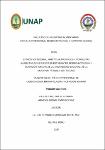Estado nutricional, hábitos alimenticios y conductas alimentarias de riesgo en estudiantes de Bromatología y Nutrición Humana de la Universidad Nacional de la Amazonía Peruana–Iquitos,2024

Date
2025Author
Del Castillo Garay, Nallely
Panduro Diaz, Ariadna Abigail
Metadata
Show full item recordAbstract
The main objective of this study was to determine the relationship between risky eating behaviors, eating habits, and nutritional status in food science and human nutrition students from the National University of the Peruvian Amazon in the Loreto region. The study was quantitative, descriptive, non experimental, correlational, and cross-sectional. The sample consisted of 169 students of both sexes from the second to fifth levels of study. The sampling method was convenience. Weight, height, blood glucose, and hemoglobin were measured, in addition to a questionnaire on food frequency to identify eating habits and a questionnaire on risky eating behaviors. 62.13% had a normal BMI, 24.85% were overweight, 8.28% were obese grade I, 0.59% were obese type II, and 4.14% were thin. 81.66% of the students had a normal hemoglobin level, 17.66% had mild anemia, and 1.18% had moderate anemia. 89.94% had normal glucose levels, and 10.06% had high glucose levels. Unhealthy eating habits accounted for 55.03%, and healthy eating habits accounted for 44.97%. Risky eating behaviors accounted for 41.42%, and 58.58% did not. It is concluded that there is a significant statistical relationship between risky eating behaviors and eating habits and nutritional status. La presente investigación tuvo como objetivo principal determinar la relación entre las conductas alimentarios de riesgo con los hábitos alimenticios y el estado nutricional en estudiantes de bromatología y nutrición humana de la Universidad Nacional de la Amazonía peruana en la región Loreto. El estudio fue de enfoque cuantitativo, descriptivo, no experimental, correlacional y transversal. La muestra estuvo conformada por 169 estudiantes de ambos sexos del segundo al quinto nivel de estudio. El tipo de muestreo fue conveniencia. Se tomó el peso, altura, glucosa y hemoglobina en sangre, además de un cuestionario de frecuencia de consumo para identificar los hábitos alimenticios y un cuestionario de conductas alimentarias de riesgo. El 62.13% presento un IMC normal, 24.85% sobrepeso, 8.28% obesidad grado I, 0.59% obesidad tipo II y 4.14% delgadez. El 81.66% nutrición presentó un nivel de hemoglobina normal,17.66% anemia leve y 1.18% anemia moderada. El 89.94% de nivel de glucosa normal y el 10.06% de glucosa alta. El 55.03%hábitos alimenticios no saludables y hábitos saludables con el 44.97%. El 41.42% de conductas alimentaria de riesgo y el 58.58% no presento dicha condición. Se concluye que existe relación estadística significativa entre las conductas alimentarios de riesgo con los hábitos alimentarios y el estado nutricional.
Collections
- Tesis [192]

